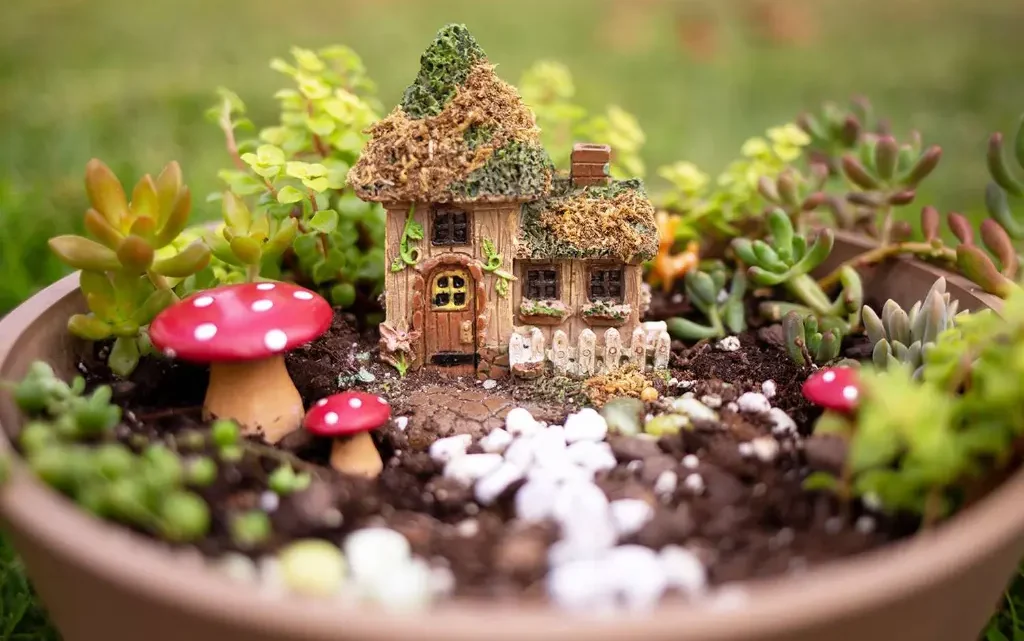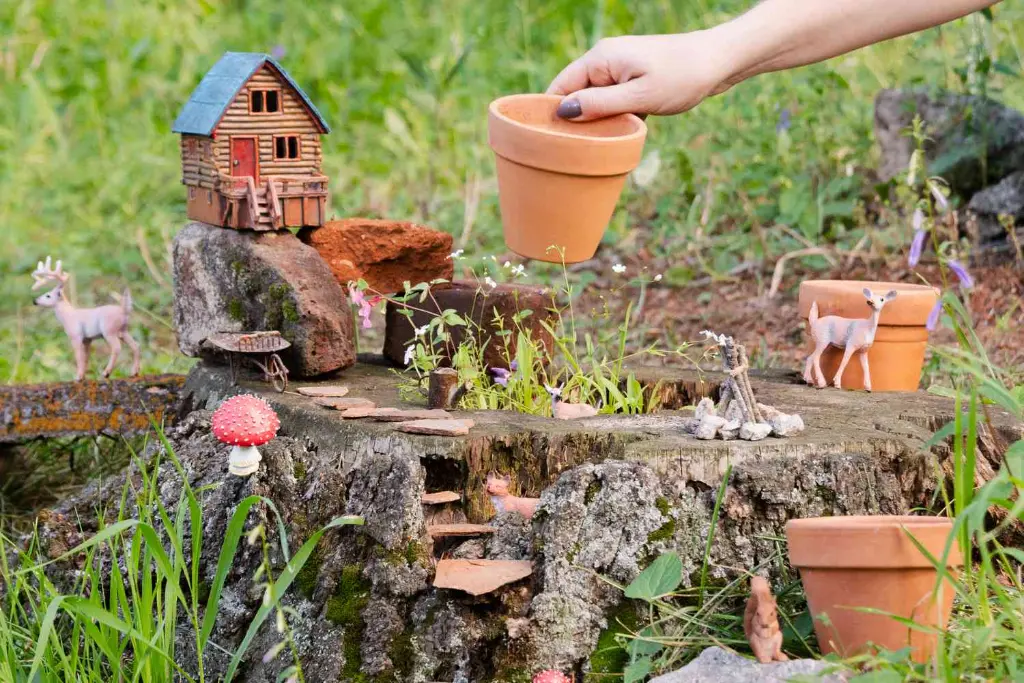
Creating a Fairy Garden: Craft a Magical Haven with Tiny Plants, Stones, and Decorative Elements
A fairy garden is a delightful miniature world that brings enchantment to your home or outdoor space. Whether you have a sprawling garden or a tiny balcony, you can create your own magical haven for these mystical beings. Let’s dive into the steps to craft your very own fairy garden:
1. Choose Your Container
Start by selecting a container for your fairy garden. It could be a wooden box, an old wagon, a flower pot, or even a plastic tray. The size doesn’t matter; what counts is your imagination.
2. Gather Materials
Collect natural materials like stones, pebbles, sand, and twigs. These will form the foundation of your fairy garden. Additionally, consider using doll furniture, tiny figurines, and miniature houses to add whimsy.
3. Select Plants
Opt for small, delicate plants like violets, begonias, and fuchsias. These create a magical atmosphere. Arrange the plants on top of the soil without planting them—let them thrive in their miniature world.
4. Decorate Creatively
Enhance your fairy garden with decorative elements:
- Miniature Bridge: Craft one from twigs, stones, or popsicle sticks.
- Tiny Furniture: Add wooden benches, tables, and chairs.
- Water Feature: Create a makeshift pond using a shallow container.
- Fairy Figurines: Place these magical beings throughout your garden.
- String Lights: Drape tiny fairy lights around trees for an enchanting glow.
5. Indoor or Outdoor?
Decide where your fairy garden will reside:
- Indoor: Use miniature plants and furniture. Transform a windowsill or tabletop.
- Outdoor: Utilize natural elements like pine cones, moss, and tree stumps. Let your garden blend seamlessly with nature.
Remember, there’s no perfect fairy garden—just let your creativity take flight! 🌿✨

Enter the enchanting world of fairy gardens, where imagination knows no bounds and ordinary landscapes transform into whimsical realms of magic and wonder. In this comprehensive guide, we will explore the art of creating a fairy garden, from selecting the perfect miniature plants to incorporating charming decorative elements that will transport you to a realm of fantasy and delight.
Unveiling the Magic of Fairy Gardens
Fairy gardens, also known as miniature gardens or enchanted gardens, are miniature landscapes designed to evoke the charm and allure of fairy tales. Originating from the concept of Victorian fairy lore, these whimsical creations have gained popularity in recent years as a delightful hobby for both adults and children alike.
What Makes a Fairy Garden:
- Tiny Plants: Selecting small-scale plants such as succulents, mosses, and dwarf varieties of flowers and shrubs forms the foundation of a fairy garden.
- Miniature Accessories: Adding tiny furniture, figurines, fairy houses, and whimsical decorations enhances the enchanting atmosphere of the garden.
- Natural Elements: Incorporating rocks, pebbles, shells, and other natural materials adds texture and visual interest to the miniature landscape.
Choosing the Perfect Location for Your Fairy Garden
Before embarking on your fairy garden adventure, it’s essential to select a suitable location that provides the ideal environment for your tiny plants to thrive. Consider the following factors when choosing the perfect spot for your enchanted garden:
Location Considerations:
- Sunlight: Most miniature plants thrive in bright, indirect sunlight, so choose a location that receives partial sun or dappled shade throughout the day.
- Moisture Levels: Ensure that the chosen spot has good drainage to prevent waterlogging, as excessive moisture can be detrimental to the health of miniature plants.
- Accessibility: Select a location that is easily accessible for maintenance tasks such as watering, pruning, and rearranging decorations.
Selecting Miniature Plants for Your Fairy Garden
The key to a successful fairy garden lies in choosing the right plants that will thrive in the miniature environment you’ve created. When selecting plants for your fairy garden, consider factors such as growth habit, light requirements, and water needs.
Ideal Plants for Fairy Gardens:
- Succulents: Succulents are ideal for fairy gardens due to their small size, low maintenance requirements, and drought tolerance. Popular varieties include hens and chicks (Sempervivum), sedums, and echeverias.
- Mosses: Mosses add lush greenery and a touch of whimsy to fairy gardens. Look for varieties such as sheet moss, mood moss, and cushion moss for a soft, carpet-like effect.
- Dwarf Shrubs and Perennials: Dwarf varieties of shrubs and perennials, such as miniature roses, dwarf conifers, and tiny ferns, add height and structure to fairy garden landscapes.
Designing Your Fairy Garden: Tips and Inspiration
Once you’ve gathered your miniature plants and selected a suitable location, it’s time to unleash your creativity and design a fairy garden that reflects your unique style and imagination.
Design Tips:
- Create Levels: Add visual interest to your fairy garden by incorporating different levels and layers using rocks, logs, or small terracotta pots.
- Pathways and Bridges: Create charming pathways using tiny pebbles or gravel, and add miniature bridges or stepping stones to guide imaginary fairies on their journey.
- Focal Points: Place eye-catching focal points such as fairy houses, gazing balls, or miniature ponds to draw the viewer’s gaze and create a sense of magic and wonder.
Adding Decorative Elements to Your Fairy Garden
No fairy garden is complete without charming decorative elements that add personality and whimsy to the miniature landscape. From tiny fairy figurines to miniature accessories, the possibilities for customization are endless.
Decorative Elements:
- Fairy Houses: Choose miniature houses or cottages made from natural materials such as wood or clay, or opt for whimsical resin or ceramic designs adorned with intricate details.
- Miniature Furniture: Add tiny benches, tables, and chairs crafted from materials such as twigs, popsicle sticks, or miniature resin for fairies to relax and unwind.
- Magical Accents: Incorporate magical accents such as miniature lanterns, fairy lights, or tiny birdhouses to create a sense of enchantment and intrigue.
Maintaining Your Fairy Garden: Care and Maintenance Tips
Once your fairy garden is complete, it’s essential to provide proper care and maintenance to ensure that your miniature plants and decorations remain vibrant and healthy.
Maintenance Tasks:
- Watering: Check the moisture levels of the soil regularly and water your fairy garden as needed, making sure not to overwater or allow the soil to become waterlogged.
- Pruning: Trim and prune miniature plants as necessary to maintain their shape and prevent overgrowth, being careful not to damage delicate foliage or roots.
- Cleaning: Remove debris, fallen leaves, and weeds from your fairy garden regularly to keep it looking tidy and prevent pests and diseases.
In conclusion, creating a fairy garden is a delightful and rewarding endeavor that allows you to unleash your creativity and imagination. By selecting the perfect miniature plants, incorporating charming decorative elements, and providing proper care and maintenance, you can craft a magical haven that will transport you to a world of enchantment and wonder. Whether you’re a seasoned gardener or a novice enthusiast, embarking on the journey of creating a fairy garden is sure to bring joy, inspiration, and a touch of magic to your life.



